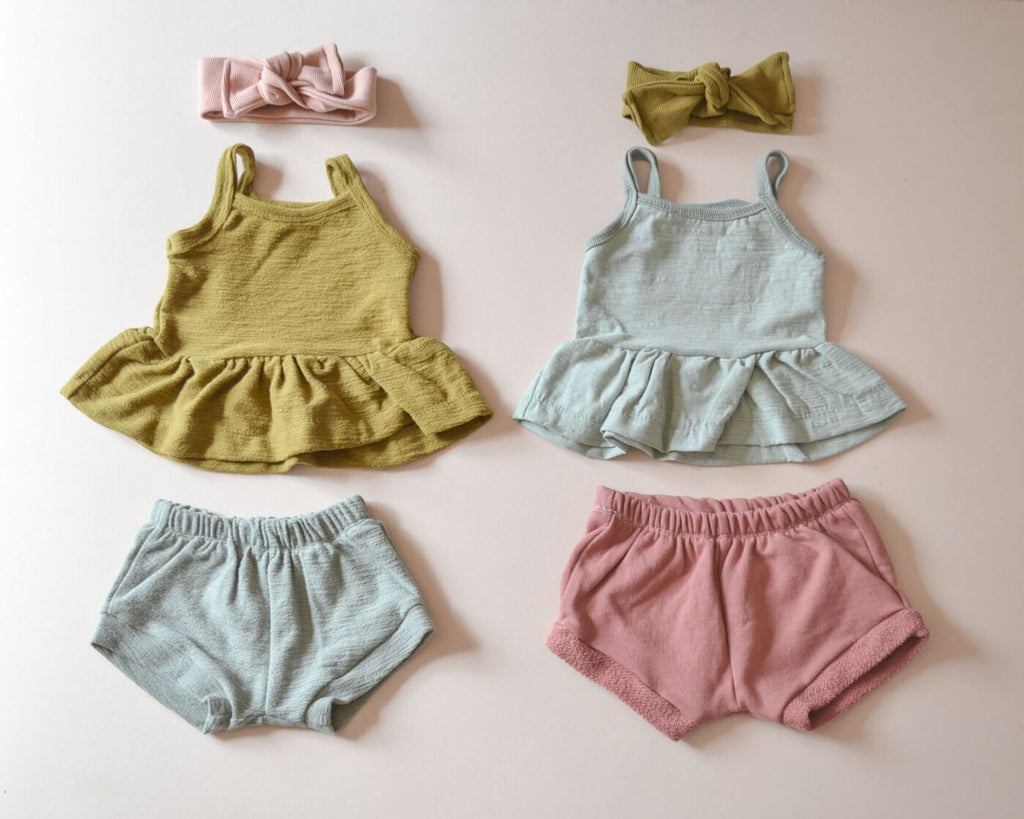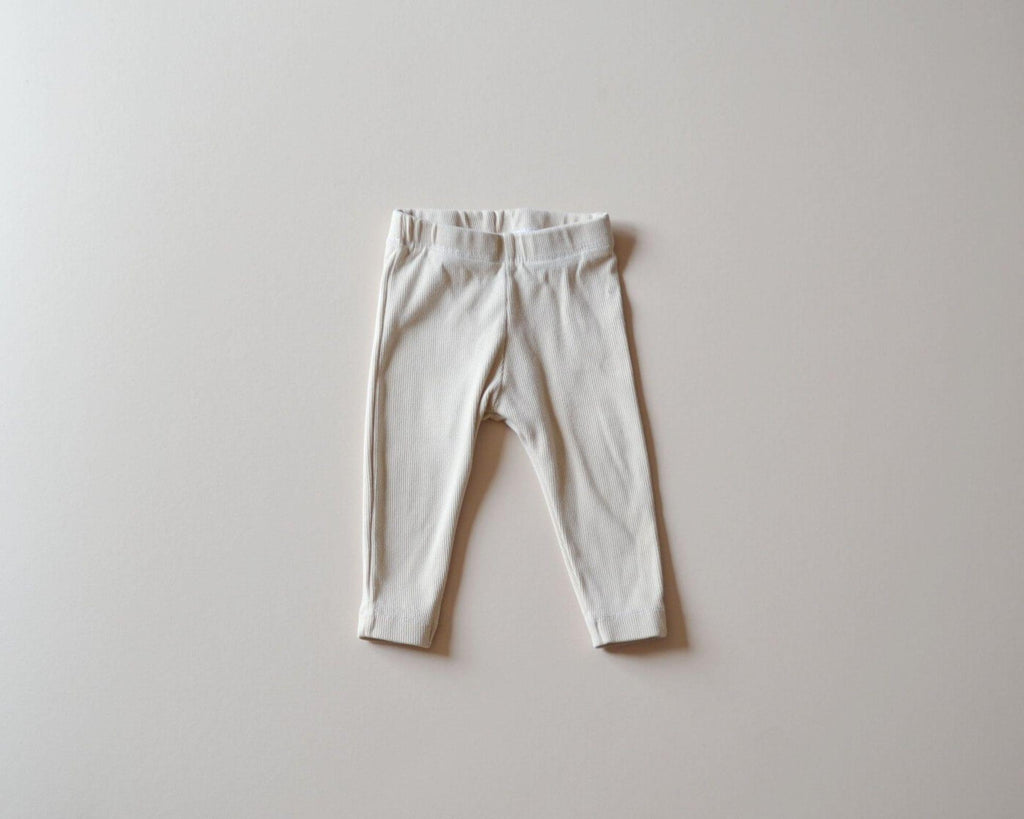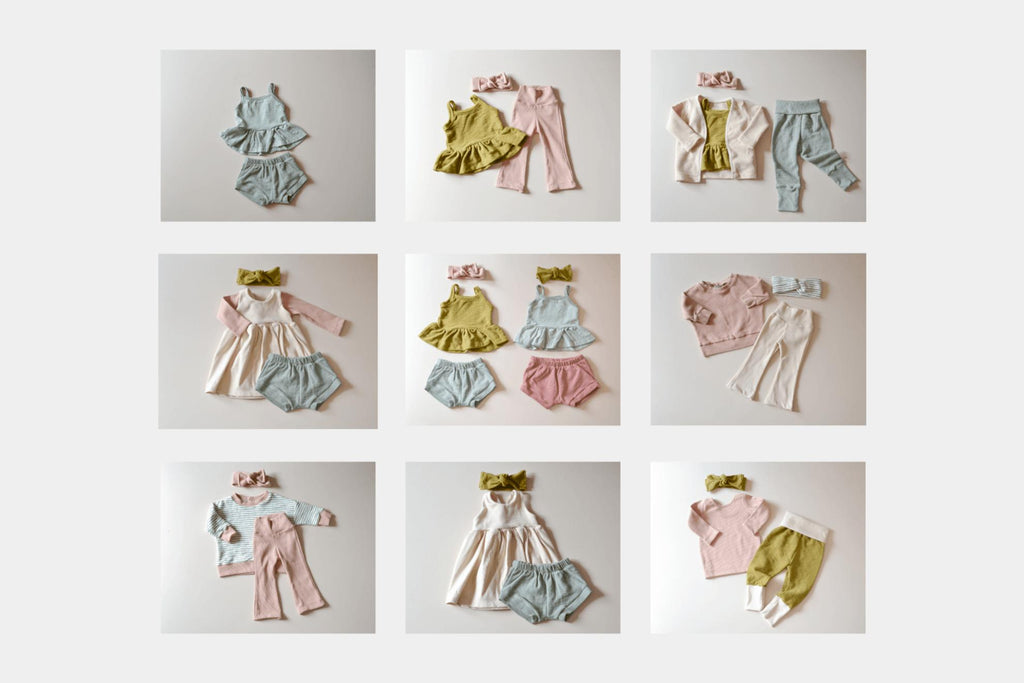
If you have been using Lowland Kids' patterns for a while, you might be familiar with the term capsule wardrobe. I remember seeing beautiful capsules on the Lowland Facebook group, and I wanted to try making my own. But once I started, I had so many questions about sewing a capsule wardrobe:
- How do I choose patterns?
- How many items do I need to make?
- What type of fabric should I get?
- How many colors should I use?
Since then, I have made several seasonal capsule wardrobes for my kids. I came up with a comprehensive method to simplify the capsule wardrobe sewing process. Read on to learn 8 simple steps to sew your own capsule wardrobe!

In This Post I Cover:
- What is a Capsule Wardrobe?
- What is a Seasonal Capsule Wardrobe for Kids?
- Benefits of Sewing a Capsule Wardrobe for Your Kids
- 8 Steps to Sewing a Capsule Wardrobe for Your Kids
- Step 1: Taking Measurements
- Step 2: Picking Colors
- Step 3: Determining Categories
- Step 4: Choosing Patterns
- Step 5: Getting Fabric
- Step 6: Cutting Patterns
- Step 7: Sewing Pieces
- Step 8: Planning Outfits
- Helpful Tips to Save You Time
- Where to Get My Capsule Wardrobe Printable Planner

What is a Capsule Wardrobe?
If you are new to the term capsule wardrobe, here is an explanation from the blog Modern Minimalism: “A capsule wardrobe is simply a collection of clothing composed of thoughtfully curated, easily interchangeable items designed to maximize the number of outfits that you can create.
Essentially, a capsule wardrobe allows you to create a variety of different looks with a small selection of clothes. A capsule wardrobe can have as many or as few clothes that work for you.”

What is a Seasonal Capsule Wardrobe for Kids?
The same thing as it is for adults! A simplified seasonal wardrobe with fewer pieces that can easily mix and match to reduce overwhelm.
I decided to sew 20 pieces for my 7-month-old daughter’s spring capsule wardrobe. I chose this number because it enables me enough extra pieces to go one week without doing laundry.
Note: You do not have to sew 20 pieces to create a capsule wardrobe—that is just the number that I chose!
The beauty of creating your own is that you can make as many or as few pieces as you need! You could also make a few pieces and supplement with pieces that you buy or already own.
Benefits of Sewing a Capsule Wardrobe for Your Kids
How many times have you gone to pick out an outfit for your child and you can find five shirts but no matching pants? If you’re like me, the matching pants are probably somewhere in the laundry that got folded but never put away.
Sewing a capsule wardrobe for your kids will ensure that you never have to dig for a matching set of clothes, and it will simplify the getting-your-kids-ready process each morning.
Since sewing capsule wardrobes for my son (3) and daughter (7 months), I barely have to think about what they are going to wear the next day. I just grab something that is weather-appropriate, and it automatically matches due to being a capsule wardrobe!
8 Steps to Sewing a Capsule Wardrobe for Your Kids

In my previous experiences creating capsule wardrobes for my children, I initially made too many pieces and chose colors that didn't mix well with others. I also didn't consider the in-between weather that required layering.

To address these issues, I created a system for planning a capsule wardrobe from start to finish. This comprehensive method simplifies the process, making it easier to sew for your kids. In this article, I'll share the 8 steps I take when creating a capsule wardrobe from scratch.
Step 1: Taking Measurements
Sewing allows you to tailor clothes to fit your child's body instead of trying to make them fit into a ready-to-wear size. Most people fall between multiple sizes, making shopping for store-bought clothing frustrating.
Before sewing a capsule wardrobe for your child, take their measurements and refer to the size charts provided with each Lowland pattern. If your child falls between sizes, you can print both sizes on one page and grade between them for a perfect fit.

Creating a capsule wardrobe takes time and effort, so you'll want to make it last as long as possible. If your child is between sizes, consider sizing up for longevity. You can also size up in shirts, as they can be worn oversized initially.
It's trickier to size up for children under a year old since they change sizes quickly. For my daughter's spring capsule, I made warm-weather pieces like dresses and shorts larger than other pieces so she can wear them throughout the summer.

Step 2: Picking Colors
When choosing colors for a capsule wardrobe, it's important to have variety while ensuring that the colors easily mix and match. Focusing on six different colors typically works best.

Choose two neutrals that mix and match with everything in your color palette, two to three colors that coordinate with each other, and one to two patterns that can seamlessly interchange with the colors in your capsule.
For my daughter's capsule, I used two neutrals, three colors, and one pattern from fabric that I had in my stash from when I operated a small sewing business a few years ago. I really wanted to use a floral pattern too, but I didn't have one on hand and decided to just use what I already had available.

Step 3: Determining Categories
In the past, I really struggled with knowing how many pieces to make when doing a capsule for my daughter. Because she is only 7-months-old, she goes through quite a few outfit changes during the day.
I wanted to have enough extra pieces so that I wouldn’t have to do laundry every day, but I didn’t want so many pieces that it was overwhelming or took me forever to make. I also already had a few pieces on hand in my daughters' upcoming size.

The capsule wardrobe that I sewed for her has 5 pairs of pants, 5 tops, 1 dress, 2 shorts, 1 cardigan, 3 rompers, and 3 headbands. This gives me enough options for 7 days, plus a few extras for outfit changes during the day as needed.
I do have some other clothing pieces in her size as mentioned in the chart above. But I have found that her 20 piece capsule wardrobe has more than enough pieces for the week--even if I did not have the additional RTW (ready-to-wear) pieces.
When choosing categories for your capsule, think about what your child actually wears on a regular basis and pick accordingly. I did not include pajamas in her capsule, but you definitely could in yours! HERE are a few of my favorite Lowland pajama patterns.

Step 4: Choosing Patterns
I put a lot of thought into the patterns that I choose for capsule wardrobes. The capsule that I am sharing in this post is for the spring in the Midwest. In the Midwest, our temperatures range from cool to hot for the next few months, so I wanted to create a capsule that would be versatile for these changes.
When planning this spring capsule, I considered patterns that layer easily. I love the Sunshine Dress because it looks cute on its own in warmer months, but it also is adorable layered with a fitted shirt like the Ellie Top and Ribbed Leggings in colder months.

Shorties are also really versatile because they can be worn with tights in colder months or on their own in the summer.
I intentionally chose patterns like the Summer Peplum Cami and the Slim Cardigan which can be layered as the temperatures change.
If you live in a place that doesn't have much variety in temperature, focus on choosing patterns that work best for the weather that you have on a daily basis.
Here are the patterns that I chose for my daughter's spring capsule wardrobe:
Tops:
- Made with slub, waffle, and rib knit

- Made with slub and rib knit

- Made with rib knit

Bottoms
- Made with rib knit

- Made with slub and rib knit

- Made with rib knit

Shorties (x2)
- Made with French Terry and Slub

Rompers
Sweater Rompers (x2)
- Made with slub, rib knit, and French Terry

Raglan Romper (x1)
- Made with slub and rib knit

Dresses
Sunshine Dress (x1)
- Made with rib knit

Outerwear
- Made with waffle and rib knit

Headbands (x3)
These are not Lowland patterns, but you can find a lot of simple, free headband patterns online, similar to these.
- Made with slub and rib knit

Step 5: Getting Fabric
It's also important to take fabric into consideration when making a capsule wardrobe. For pullovers and rompers, I recommend using French Terry, waffle knit, or slub. Rib, jersey, and waffle knits work well for dresses and headbands.

For leggings or fitted pants, try rib knit or a stretchy jersey fabric. French Terry and slub are also great options for looser pants and shorts. If you live in a cooler climate, choose lighter-weight fabrics like jersey, rib, or slub. For warmer climates, choose waffle knit or French Terry. And if you live in a place where the weather drastically fluctuates throughout the day, you can use a combination of the fabrics mentioned above for layering pieces.

Step 6: Cutting Pattern Pieces Out
When you're working with so many patterns and pieces, it can be kind of overwhelming to stay organized. If you use printed patterns, I recommend keeping them in a three-ringed binder with plastic sleeves.

Additionally, it saves a lot of time if you cut everything out at once. When making my daughter's capsule, I chose the colors/fabric for each individual piece as I went.

Because I cut everything out at once, I was able to see if there were certain colors that I hadn't used very much in her capsule. As I cut the items out, I put a sticky note with the pattern name and size on top of the pieces so that I can stay organized when going back to sew the pieces together.

Step 7: Sewing Pattern Pieces Together
If using matching thread, I recommend sewing the patterns that have the same color fabric. If you're not worried about matching thread, try sewing the same types of pieces at once so that you can focus on one pattern at a time.

Step 8: Planning Outfits
The last step to planning—or more like implementing—a capsule wardrobe is to plan outfits. This is my favorite part!
See how many different outfit combinations you can come up with! I like to try to do a variety of monochrome outfits and mixing and matching.

The thing that I love most about sewing capsule wardrobes for my kids is that I can reach in their drawer and everything already matches. I don’t have to even think about creating a cohesive outfit for them in the morning!
Helpful Tips to Save You Time
- Don’t have time to make a 20-piece capsule? Make five tops, five bottoms, one romper, and one accessory. You can save even more time by using the same pattern for the tops and bottoms and just switching out the fabric.

- Sew simple patterns first so that you make visible progress, and finish with the more difficult patterns.
- If you don’t want to spend a lot on fabric, you can upcycle old blankets or clothing items. You can also use Lowland’s Bundle Discount Codes when purchasing multiple patterns to make.

Conclusion
Ready to make your own capsule wardrobe? These eight steps help simplify the process but still leave so much room for creativity and making it your own.

If you make your own capsule wardrobe, share it in the Lowland Facebook Group or on Instagram using the tag #lowlandkidscapsulewardrobe.

I can't wait to see what you create!

If you are interested in sewing your own capsule wardrobe and need a way to keep all of the measurements, patterns, and fabric organized in one place, you can check out Lauren's printable Sew Your Own Capsule Wardrobe Planner HERE.

Some of the sample organizational pages included in this blog are included in the planner. Stay organized throughout the sewing process, and create a capsule wardrobe that is completely tailored to your child.




